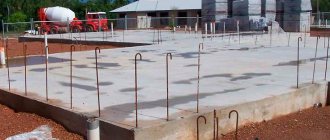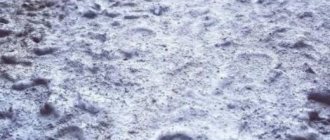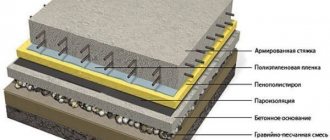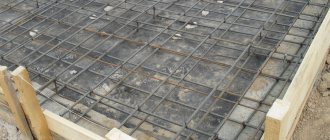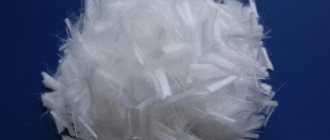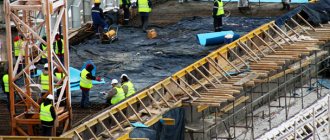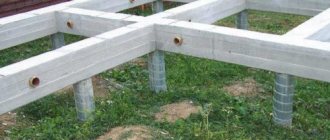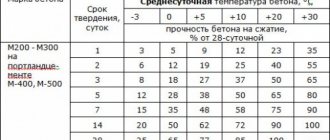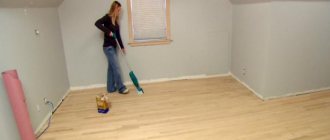When starting the construction of monolithic concrete structures, you should familiarize yourself with all the rules for caring for them in advance. They are necessary for the concrete to gain its original strength and serve for many years. Otherwise, cracks will begin to appear on its surface, which will lead to shrinkage of the building and loss of its functionality. SNIP provides for concrete maintenance at any time of the year, but if you can choose a construction season, it is better to choose the summer option.
At this time of year, it is necessary to provide the concrete with optimal hydration conditions in order to achieve maximum structural strength. All protective measures take place in two stages.
Stages of concrete protection
- Initially, an analysis of the environmental impact on the concrete pavement should be carried out. It is its insufficient resistance to this that affects the subsequent strength of the entire structure. After the design is completed, the first stage begins. It includes the preparation of the optimal composition of the concrete mixture, which will withstand external influences. To do this, various impurities are added to improve density, frost resistance, crack resistance and water resistance.
- The second stage is to protect the already laid coating. To do this, it is necessary to cover the surface of the concrete with a special coating that will prevent or limit its contact with the environment. This is done to control the moisture content of the concrete mixture and protect it from destruction. It is also important to maintain an optimal temperature on its surface, which does not always coincide with natural temperature. Therefore, shelter is required.
Methods for caring for concrete
Complete hardening of concrete takes about a month, of which the first two weeks the concrete gains almost eighty percent, so the maintenance process takes a long time. If the moment is missed, cracks will appear on the surface of the concrete, which will lead to a significant loss of strength and functionality. Maintenance of concrete in the summer SNIP provides for all this. Their main requirement is to maintain the level of humidity on the surface of the structure. It is achieved by preventing evaporation or regularly maintaining the level of humidity by replenishing it. The required amount of water is added to the mixture that is still being prepared, which should be kept until it hardens completely, that is, for a month.
The speed of drying is also affected by the ambient temperature. When large monolithic structures are heated unevenly, large cracks appear on them, and when foundations or floor coverings dry out, microcracks form. All this leads to a large loss of strength and shrinkage of the building. Drying slows down, and sometimes even stops, the hardening process. At this time, the volume occupied by concrete also changes. All this should be taken into account when choosing cement for preparing the mixture.
In different temperature conditions, the hardening period also varies. For example, at temperatures above ten degrees Celsius and air humidity of more than eighty percent, the full hardening time increases. This is because under these conditions, water will penetrate into the concrete slowly. Surface maintenance will take about two weeks, as with other slowly hardening cement mixtures. Portland cement will require a moistening period that is half as long.
All methods of maintaining the required moisture content of concrete can be divided into three:
- watering;
- coating with a protective composition (allows you to retain moisture and avoid negative environmental influences);
- aging with salts (used in winter).
All work to moisten the surface with water must be carried out from a sprayer, otherwise a strong jet can wash away the concrete. The first watering is carried out after a couple of hours in very hot weather and after ten hours in average temperatures. Subsequent wetting depends on environmental conditions and the composition of the cement itself. For example, low-heat grades will require care for a couple of weeks, aluminous (quickly hardening) grades should be moistened for only a day, of which the first eight hours should be heavily saturated with moisture, and the remaining time should be completely moistened. In any case, the regularity of this process significantly reduces the risk of cracks. But do not forget that during watering the concrete cools.
Typical mistakes when concreting in summer
Preventing overheating of the concrete solution, water loss, and the occurrence of plastic shrinkage should not be done by methods that reduce the quality of the material. The addition of water to the solution is not allowed or is significantly limited - this can lead to a change in the class of concrete and an increase in its heterogeneity. Lump ice should not be used when adding it to the mixer of a concrete truck, since the risk of it getting into the formwork is very high.
At the stage of preparing the solution, conscientious manufacturers do not use heated ingredients. Fillers and cement are stored in the shade and supplied to the RBU at a temperature that does not overcome the technological barrier of overheating the solution. Transportation of the solution by mixer is carried out along short routes with limited container turnover. You should find out the price of concrete with delivery per 1 m3 along the shortest route and observing the temperature regime in advance.
Care rules during the warm season
During this period, the air temperature rises significantly, which means that caring for concrete in the summer will have its own characteristics. It all comes down to maintaining a temperature on its surface no higher than twenty-five degrees Celsius and an optimal level of humidity throughout the entire hardening period. To do this, concrete must be covered immediately after pouring to reduce moisture evaporation, which will lead to cracking. Straw, sheets of tin, burlap and any other materials will do. Sometimes, when moisture evaporates, traces of salts remain on the concrete surface, which destroy the surface layer. To prevent their interaction, it is recommended to cover the concrete so that the materials do not come into contact with its surface. To do this, it will be enough to maintain a distance of a couple of centimeters. All subsequent moistening occurs directly through the shelter, which retains salts and allows moisture to pass through. The entire process of laying and maintaining concrete in hot weather is based on certain rules:
- regularly maintaining the level of humidity on the surface;
- at elevated temperatures, moisten the formwork;
- protection of the surface from the sun and wind;
- avoid contact with rain and melt water;
- exclude the possibility of mechanical impact on the surface.
In addition to the rules for protecting the surface, you should also adhere to the rules when pouring concrete. To do this, it is necessary to carry out the main work in the morning or evening, when the air temperature is not too high. It takes no more than an hour to deliver the material to the site or prepare it on site. Immediately after laying, protect the concrete surface from the sun and moisten it regularly throughout the curing period. The frequency of watering, as well as its intensity, depends on the air temperature. In forty-degree heat, not only the concrete, but also its formwork and shelter should be moistened. Particular attention must be paid to the nodes and edges, and it is advisable to water the plant from a sprayer.
If these standards are ignored, the strength of the concrete coating is reduced by half due to rapid drying. And the full period for gaining brand strength of concrete depends on temperature, which has been proven by scientific research, so you need to take weather conditions into account when drawing up a schedule.
Paving stones and paving slabs
Compressive strength alone does not guarantee the durability of concrete. In accordance with the standards, concrete must be dense, since the lower the porosity and permeability, that is, the denser the cement stone, the higher the resistance to external influences. Therefore, timely, constant and sufficiently long-term care of concrete is necessary so that just in the surface zone it actually achieves the necessary properties based on the composition of its mixture. According to DIN 1045-3 [3], concrete maintenance must be carried out during the first days of hydration “to reduce premature shrinkage, ensure sufficient strength and durability of the edges of the concrete structure, prevent freezing and reduce dangerous vibration, impact or damage.” This specification describes the necessary concrete maintenance measures.
1. Purpose of concrete care
Until the freshly poured concrete mixture reaches sufficient hardness, it must be protected from: - premature drying - extreme temperatures and sudden changes in temperature - mechanical stress - chemical influences - dangerous vibrations
The unformed exposed surface of fresh concrete must be additionally protected from rain. Protection against premature drying is necessary in order, among other things, not to disrupt the strength development of concrete due to dehydration and affect the durability of concrete. The consequences of premature dewatering are low surface strength of concrete, a tendency for sand to peel off from concrete, increased water absorption, reduced resistance to atmospheric influences, low resistance to chemical influences, the formation of premature shrinkage cracks, and an increased risk of subsequent shrinkage cracks. So-called premature shrinkage cracks are formed primarily due to the reduction in volume of freshly prepared and freshly placed concrete in exposed surface areas due to rapid drying.
If concrete dries, its volume decreases and it shrinks. Preventing this deformation creates structural and internal stresses that can lead to ruptures. Shrinkage cracks appear first on the surface of concrete, and then can penetrate deeper. Therefore, care must be taken to dry the concrete slowly. Drying of concrete should begin when the concrete has reached a tensile strength at which it can withstand shrinkage stress without cracking. This process is called "plastic shrinkage". As long as the concrete remains plastic, the resulting shrinkage cracks can be closed again by additional compaction (eg using a surface vibrator).
The lower the relative humidity and the higher the wind speed, the faster the concrete dries. Temperature also plays a significant role, in particular, the difference between the temperature of hardening concrete and the temperature of its surroundings. If the surface of the concrete is warmer than the air surrounding it, then its drying speeds up. Particular attention should be paid to unformed surfaces, such as road surfaces and screeds. The following diagram shows the scale of water evaporation per m2 of concrete surface under various conditions (Fig. 1).
| Rice. 1 Drying of concrete depending on wind speed, air humidity and temperature influence. |
The diagram shows, for example, that at an air and concrete temperature of 20 °C, a relative air humidity of 50% and an average wind speed of 20 km/h, 0.6 kg of water per hour can evaporate from 1 m2 of concrete surface. As the difference between the temperatures of concrete and air increases, the degree of evaporation increases. This can happen both in summer (for example, cold morning temperatures) and in winter, in particular when delivering warm concrete mix. The diagram clearly shows that wind speed has an even greater impact on evaporation. Particular attention should be paid to this when creating flat and open structures. An example explains the meaning of these figures in practice: In a freshly laid concrete mixture with a water content of 180 l/m, a layer 1 cm thick contains 1.8 kg of water per square meter. An evaporation rate of 0.6 kg/m2 and an hour when calculated means that concrete loses an amount of moisture within three hours that corresponds to the total water content of a concrete layer 1 cm thick. This has a negative impact on the strength, wear resistance and tightness of the surface zone becomes more significant.
The effects of temperature extremes (such as strong solar radiation), sudden changes in temperature (such as cooling due to rain) and heat generated by cement hydration result in temperature differences between the surface and core of the structure. The consequence is stress, since various types of deformations in the building element, caused by temperatures, interfere with each other. Often in fresh concrete, which has a low tensile strength, this leads to the formation of cracks. Therefore, protection from external influences is necessary. It is necessary to limit the temperature difference between the surface of the structure and its core due to the heat released during hydration (typically < 20 K, for very thick structures < 12 K depending on the circumstances). Temperature also affects the strength gain of concrete: it slows down at low temperatures, and at temperatures below + 5 ° C this process proceeds very slowly. In order to avoid damage due to freezing, unset or fresh concrete must be covered with a layer of heat-insulating material, and, if necessary, heat must be supplied.
If concrete, protected from extraneous water (rain, snow), has reached a strength of 5 N/mm2 or its temperature has not dropped below 10 °C for 3 days, then such concrete is considered frost-resistant, that is, resistant to single freezing. Fresh concrete cannot withstand repeated freezing and thawing without causing various damages.
Work to protect concrete during cold and hot weather, as well as concrete care measures in general, is additional work. Only preventive measures carried out during concreting at an air temperature below 5 ° C, as well as before concreting work at an average air temperature above 30 ° C, maintained for 48 hours, in accordance with the rules for performing contract construction work, some relate to “special work” subject to additional payment. In general, concrete care that goes beyond this scope can be taken into account as a separate item in the list of works and services.
Mechanical loads such as oscillations and severe vibration during setting and initially during curing (for example, when working on adjacent building elements or on a road structure under moving traffic) can damage a concrete structure if the concrete structure or bond is thereby weakened between concrete and reinforcing steel. The work must be planned in such a way that no such loads occur within 36 hours after the concrete mixture is laid or the concrete begins to harden. Damage from subsequent work can be avoided by stripping the formwork as late as possible and, after removing the formwork, by using edge protection and protective coatings. Damage that occurs on uncured or fresh concrete from raindrops and running rainwater can be prevented by covering the entire surface with film or mats. Chemical attack from substances in groundwater, soil or air can damage well-mixed and placed concrete and render it unsuitable for its intended use.
2. Methods for caring for concrete
The following concrete care measures should not be carried out in rainy, damp weather with a relative humidity of 85% during the first days of hydration. Since air humidity changes during the day, the average daily air humidity should be taken into account. An average over a longer period of time is not acceptable. Since our climate zone is characterized by relatively unstable weather, and a more accurate forecast can only be obtained three days in advance, it is necessary to regularly check the air humidity.
Separate rules for reinforced concrete on watertight concrete structures or additional technical contractual conditions for engineering structures) override the provision based on the maintenance of concrete taking into account air humidity and require maintenance based on traditional measures. Preventative measures to protect against pre-drying include:
— Curing the concrete in the formwork — Using film — Using a moisture-retaining coating — Applying care products to the concrete surface — Constantly spraying with water, storing under water — A combination of these measures
The most common measure to protect against pre-drying is to thoroughly cover the concrete surface with a vapor-proof synthetic film, the thickness of which should be 0.2 mm. The film should be overlapped on the still wet concrete and secured at the joints (for example, you can put weights in the form of boards on the joints, or fasten them with adhesive tape).
The use of synthetic film is recommended primarily for decorative concrete. In this way, unwanted surface fading caused by wet handling or rain can be avoided. In this case, the film cannot be applied directly to the surface of the concrete, so that condensation does not get into it, which in turn can lead to fading. It is necessary to prevent the occurrence of drafts between the concrete surface and the coating. When covering the concrete surface with moisture-retaining materials, such as jute fabric, straw matting, a layer of sand or other materials, the coating must always remain wet and, if necessary, it must be additionally covered with a film to prevent rapid moisture loss.
Concrete care products can be applied to the surface of a concrete structure using standard equipment (for example, a garden sprayer with an appropriate spray nozzle). It is necessary to apply the product as early as possible and distribute it evenly over the surface: on open concrete surfaces - when the visible film of water disappears (the concrete surface will become dull-moist), for concrete laid in formwork - immediately after removing the formwork. It is important to constantly maintain the film of the sprayed substance and ensure that when applied per square meter, the amount of substance specified in the operating instructions is used. Light dyes are often mixed with such substances, so you can easily determine whether the product is sprayed evenly over the surface. In case of high temperatures, strong solar radiation, strong wind exposure or very low temperatures, additional measures must be taken. Concrete care products containing wax for painting, coating and lining reduce the adhesion of the concrete surface. Therefore, in such cases it is necessary to remove this product or its residues, unless a negative impact on subsequent work is excluded. There are also combination products based on PVC copolymers, epoxy resin solutions with moisture-insensitive solvents, etc., which offer both concrete care and protection or give it color.
Table 1: Methods of additional processing of concrete depending on the temperature of the concrete surface and air
| N | View | Events | Surface/air temperature [°C] | ||||||
| below -3 | from 3 to +5 | from +5 to +10 | from +10 to +15 | from +15 to +25 | taller + 25 | ||||
| 1 | Cover with a vapor-proof film / spray a concrete care product | + wetting with water | Coat or apply a film and moisten, additionally: - moisten the wooden formwork - protect the steel formwork from the sun - cover and moisten the exposed concrete surface in the formwork | (X)2) | X | ||||
| 2 | Cover or apply film if necessary, additional measures given in line 1 | X | X | X | |||||
| 3 | + | Cover or apply film and put insulating material | X1) | ||||||
| Use of thermally insulating formwork (e.g. wood), steel formwork must be surrounded by insulating matting | |||||||||
| 4 | Cover and put insulating material; block off the workplace (tent), if necessary, heat (for example, a heating gun) additionally: maintain the concrete temperature > +10 ° C for 3 days | X | |||||||
| 5 | moisten with water | constantly maintain a film of water on the surface of the concrete | (X) | X | X | ||||
1) do not wet; protect from rain/melt water 2) under unfavorable conditions (for example, strong wind) and exposure classes XM, XD, XF, XS
A traditional measure to protect against premature drying is also to spray the concrete surface with water. The surface of the concrete must remain moist at all times, since alternating drying and wetting can lead to stress in the concrete and, thus, to the occurrence of cracks. In this case, it is necessary to avoid direct spraying of concrete with a strong stream of water, since as a result of sudden cooling of the surface, in particular massive structures, cracks can also form in the concrete. Nozzles or perforated hoses used for watering lawns can be used as auxiliary means. To care for horizontal surfaces, they can also be immersed in water.
During frost, wet curing of concrete is not permitted. Since at air temperatures below 0 °C the film, although it prevents moisture loss, does not protect the concrete surface from cooling, the use of a heat-insulating coating is provided as an additional measure. When curing concrete in formwork, it is necessary to moisten the wooden formwork, which absorbs moisture well, and protect the steel formwork from heating by the sun's rays, and at low temperatures, from too rapid and strong cooling. The dependence of the described types of treatment on air temperature is shown in Table 1. Concrete can be protected from the dangerous influence of temperature as a result of strong solar radiation and high temperature using a sun canopy or a wet coating. Fresh concrete must be protected from exposure to chemically harmful groundwater, for example by drainage.
3. Duration of concrete curing
The minimum curing time for concrete depends on the exposure class, surface temperature and strength development in the concrete. The strength gain r, in turn, depends on the composition of the concrete. It is determined by the ratio of the average compressive strength after 2 days (fcm2) and 28 days (fcm28) using separately prepared samples in the laboratory during primary testing or using similar concrete (same grade of cement and same water-cement ratio). The strength gain of concrete of a given quality and, if necessary, standard concrete can be found from the technical specifications for ready-mixed concrete. If, in a special application, the compressive strength is determined not after 28 days, but at another time, then to obtain the value of r, instead of fcm28, the average value of the compressive strength at the corresponding point in time should be used (for example, fcm56)
Table 2: Minimum curing time in days for concrete according to DIN 1045-3 for all exposure classes except X0, XC1 and XM
| Surface temperature v [°C]2) | Minimum duration of concrete curing in days | |||
| Concrete strength gain r = fcm2/fcm281) | ||||
| fast r > 0.5 | average r >0.30 | slowly r > 0.15 | very slow r < 0.153) | |
| 1 v ≥ 25 | 1 | 2 | 2 | 3 |
| 2 25 > v ≥ 15 | 1 | 2 | 4 | 5 |
| 3 15 > and ≥ 10 | 2 | 4 | 7 | 10 |
| 4 10 > and ≥ 5 | 3 | 6 | 10 | 15 |
1) Intermediate values cannot be included. 2) Air temperature can be used instead of concrete surface temperature. 3) Concrete with a very slow strength gain is not common.
Table 3: Minimum curing time in days for concrete exposure classes XC2, XC3, XC4 and XF1 - alternative method depending on the temperature of the fresh concrete mixture
| Temperature of fresh concrete mixture 9 fb | Concrete strength gain r = fcm2/fcm281) | ||
| fast r ≥ 0.5 | average r ≥ 0.30 | slow r ≥ 0.15 | |
| v ≥ 15 | 1 | 2 | 4 |
| 15 > v ≥ 10 | 2 | 4 | 7 |
| 10 > v ≥ 5 | 4 | 8 | 14 |
1) Intermediate values cannot be included.
Under environmental conditions that correspond to all exposure classes other than X0, XC1 and XM, concrete must be cured to achieve 50% of its characteristic surface strength. This requirement is converted in Table 2 depending on the strength gain and surface temperature of the concrete into a minimum curing time in days. If you do not adhere to the minimum curing period given in Table 2, you must have a special document on the actual strength gain in the structure.
Instead of the values in accordance with Table 2 for exposure classes XC2, XC3, XC4 and XF1, the determination of the duration of concrete curing can be carried out by measuring the temperature of the fresh concrete mixture vfb at the time of placement and measuring the strength gain of the concrete. In accordance with this, the required curing duration of concrete is given in Table 3. When using steel formwork or when calculating the curing time of concrete not placed in formwork, only Table 3 can be used if appropriate measures prevent excessive cooling of the concrete in the initial stage of hardening.
Thereafter, the minimum curing time is as follows: for exposure classes X0 and XC1 (concrete without reinforcement or embedded metal, internal elements): 12 hours for concrete with a placing time > 5 hours: corresponding increase (min. for delay time) - for concrete surface temperatures < 5 °C: increase for a period of time with temperatures below 5 °C - for exposure classes XM (wear): until 70% of its characteristic strength is reached, without special confirmation the values in Table 2 must be doubled.
If there are special requirements for the durability of the surface of a building structure, when issuing a task, it is recommended to agree on an increased duration of curing in accordance with Table 2, for example, with high frost resistance and resistance to the effects of defrosting salts, against chemical influences or the penetration of liquids and gases (construction of hydraulic structures, wastewater treatment plants , pits, containers, etc.)
The effect of aging on the tightness of concrete or cement stone can be seen in Fig. 2. The diagram shows the water permeability of cement stone depending on the number of capillary pores in it and shows, among other things, the relationship between the number of capillary pores, the water-cement ratio and the degree of hydration (which is included in the achieved strength coefficient). On the one hand, the diagram shows that when fully hydrated, concrete with a water-cement ratio of 0.70 is much more permeable to water (and thus diffusionable) than concrete with a water-cement ratio of 0.50. In addition, it can be seen that concrete with water-cement ratios of 0.40, 0.50 and 0.60 have almost the same permeability if it hydrates to only 60%, 80% or 100%. Since the hydration or strength gain and increase in permeability of a concrete surface is directly dependent on the sufficient addition of water to the cement, it becomes clear how crucial the curing of concrete is to its quality and durability.
4. Instructions for curing decorative concrete
Despite the fact that clear rules for the care of concrete were previously given, the care of structures with a surface made of decorative concrete in some cases is complex or difficult from a technical point of view. Concrete maintenance measures naturally have an impact through the surface of the structure. They must be carried out in such a way as not to have an undesirable effect on appearance.
| Rice. 2 Water permeability of cement stone depending on the number of capillary pores and water-cement ratio. |
With regard to conventional built-in elements, the problems are in most cases minor, as such elements of exposure class XC1 with a minimum compressive strength class of C16/20 only require curing for twelve hours. However, in practice, for structural and technical reasons and to achieve a closed and sealed surface of the building element, concretes are used that gain strength within 28 days. Therefore, as a rule, when determining the time of stripping, it is necessary to take into account the curing time of the concrete.
More difficult is the maintenance of building structures with decorative concrete located in the open air. Exposure classes XC4 and XF1 usually apply here, which requires determining the minimum curing time in accordance with Table 2 or 3. Thus, from a concrete mixture with cement mortar usual for decorative concrete and laying temperatures that satisfy practical requirements, in most cases, average periods are formed by comparison curing periods ranging from one to six days, however, curing structures with decorative concrete requires appropriate planning and careful implementation.
Since it is necessary to avoid any contact of freshly laid decorative concrete with water (including rainwater), protection against evaporation is taken into account as care, usually by covering the surface with plastic film. Since running condensation can have the same destructive effect on the surface as light rain, it is necessary to ensure slight air circulation in order to avoid the formation of large amounts of condensation. For the same reason, the film cannot be applied directly to the surface of decorative concrete, but leave a distance of several centimeters to the surface. In order to ensure this distance, auxiliary structures made from wood waste are often installed on concrete structures, which in turn, in direct contact with decorative concrete, can lead to discoloration and the formation of deviations on the surface of the concrete. Therefore, auxiliary structures that provide the distance between the film and the surface must be made of plastic parts or installed on polyethylene film at the points of contact with the surface of decorative concrete. Since limited air exchange is necessary, drafts should be avoided if possible, as they will dry out the edges of the concrete structure. Safety barriers made of polyethylene film are sensitive to atmospheric influences, such as wind or heavy rain.
Additional protections
To increase the strength of the concrete coating, various protective mixtures are sprayed onto its surface. They are white, black and colorless.
Black protects well from wind and direct sun, but its surface, on the contrary, increases heat absorption and overheats the concrete. Black bituminous mastic acts even worse; it evaporates a large amount of moisture during the wind. White additives, due to their color, reduce heat absorption, while colorless additives do not affect the appearance of concrete. Modern technologies have made it possible to obtain a product that creates a transparent film on the surface. This type of coating can be found on the floors of large hypermarkets. It involves improving the durability of concrete at average temperatures and humidity. But even when using such additives, one should not forget about the need to regularly moisten the coating.
Rules for caring for monolithic structures
Large surfaces lose moisture much faster, so they should be moistened more often. To ensure sufficient watering, you can build a continuous irrigation system, it is important to use galvanized pipes for this. The fact is that tap water contains a lot of iron, which will settle on the surface of the concrete, and galvanized pipes will prevent this. If the structure is being erected using concrete blocks, then each of them must be watered from all sides and must be covered with film or a protective compound.
Problems that arise during the production of concrete structures
Now let's look at the main problems that may arise during the manufacture of individual building elements from concrete. The most common problem is a cracked surface. There are several reasons for this phenomenon, but the main one is incorrectly selected proportions of concrete components. Let's consider the influence of one or another component on the properties of concrete.
The water in the concrete solution is responsible for its thickness. Concrete that is too liquid contains a lot of dissolved air, the components are mixed unevenly, and cement laitance flows down when pouring. At the same time, the structure weakens and its surface bursts. A burst surface is the reason that crushed stone in the liquid solution settles at the bottom, and only sand remains at the top, which is not designed to withstand heavy loads.
Thick concrete is an ideal option, but it is quite difficult to obtain it under “field” construction conditions. At reinforced concrete factories, vibrating tables or vibrators are used for its production, which evenly distribute the constituent components throughout the entire volume, but delivering such concrete to the construction site is quite expensive.
When constructing private houses, concrete is usually prepared on site using a concrete mixer. The consistency should be neither liquid nor thick, and it can be compacted with a stick or a vibrator.
